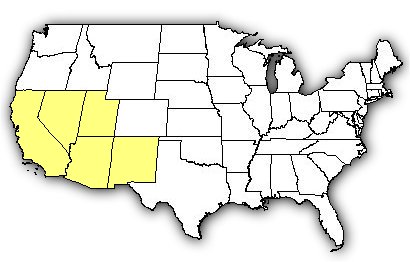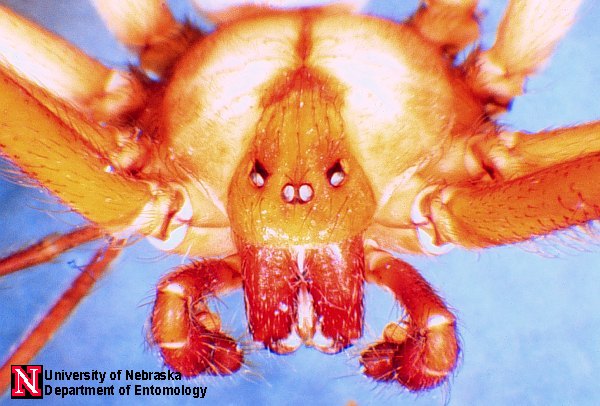DESERT RECLUSE
Scientific name
Loxosceles deserta
Size
The average size of mature Desert Recluse spiders is approximately 1/2 of an inch, with a leg span of 1.5 to 2 inches. Male and female are similar in size.
Description
Desert Recluse spiders are generally yellowish-tan to tan in color. The typical violin shaped marking of the recluse spiders is not apparent on the Desert Recluse. The abdomen is a uniform color, with no markings on it.
Desert Recluse spiders, and the other related recluse spiders, have six eyes arranged in three pairs of two. This is a rather unique feature, as most spiders have eight eyes. A magnified view of the eyes can be seen in a photo below.
Distribution
The Desert Recluse is found in Arizona, California, Nevada, New Mexico, and Utah. Outside the United States,
the Desert Recluse is found in Mexico.

Map does not show area of true distribution, only the states in which there is a population.
Actual distribution in any highlighted state may be limited.
Notes
The Desert Recluse is known to have a necrotic bite. This means that the bite causes severe damage to the skin and surrounding tissue, resulting in a large open sore, called a necrotic lesion, that takes a long time to heal. In some cases, systemic effects (i.e. headache, nausea, abdominal cramps, joint stiffness, and/or fever) have been reported as well.
Often the Recluse spiders are called Violin Spiders or Fiddleback Spiders, because of the characteristic violin marking. Not all recluse spiders have the Violin marking, such as the Desert Recluse which lacks the violin. Recluse spiders are also called Brown Spiders in some areas.
Magnified eyes of a recluse spider. Note there are only six eyes, arranged in three pairs.
Most spiders have eight eyes.

Photo used by permission:
© Jim Kalisch
Department of Entomology, University of Nebraska-Lincoln
For more information on dangerously venomous spiders, please see the Venomous Links page.
Terms and Conditions | Privacy Policy
Change your Cookies Preferences
